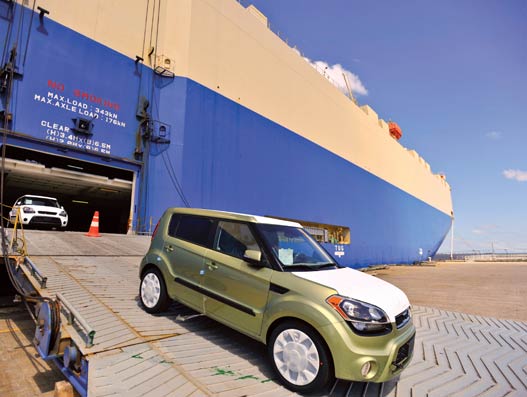
Surging Automobile trade
According to PwC Autofacts, as many as seven new plants are expected to open between 2013 and 2020, and vehicle production in the U.S., Canada and Mexico is expected to expand from 16.2 million units in 2014 to about 19 million units by 2020. What do these figures signify for ro-ro vehicular trade? The global […]

According to PwC Autofacts, as many as seven new plants are expected to open between 2013 and 2020, and vehicle production in the U.S., Canada and Mexico is expected to expand from 16.2 million units in 2014 to about 19 million units by 2020. What do these figures signify for ro-ro vehicular trade?
The global ro-ro market has managed to balance demand and supply remarkably well over the last decade, subsequent volatile demand and the growth of new and sometimes fragmented trade lanes.
In the first nine months of 2014, 15 million tonnes of ro-ro cargo was handled by the port of Rotterdam, 8 percent more (+1.1m tonnes) than in the same period of 2013. The port said the increase was due almost entirely to the growth of the British economy.
“The difference between cargo leaving Rotterdam (8.1 million tonnes) and incoming ro/ro cargo (6.9 million tonnes) is smaller than one would expect from an import-focused economy like Britain, Certainly now that the British pound is also expensive in relation to the Euro, therefore putting a brake on exports,” said the port in a statement.
Ro/ro transport from Rotterdam to Britain focusses very much on foodstuff: a lot of fresh fruit and vegetables, but also preserved products, frozen produce (meat, dairy products, a lot of potato products), onions and drinks (wine, beer, soft drinks). Consumer durables such as furniture and white goods, hygienic paper products (nappies, toilet paper, tissues, etc.) and car parts are also important.
With foodstuffs, the port benefits from the direct proximity of Zeeland’s agriculture and the greenhouse horticulture in the Westland and around Bleiswijk, Barendrecht and Venlo. Dutch products are also combined with European products and with exotic fruit from South America and South Africa in particular.
Another important gateway for U.S imports for cars is the Port of Baltimore. Baltimore last year handled more than 750,000 cars, the most among any U.S. port. Recently, a new berth was opened at the port that could drive more automobile shipping to the city.
The port opened the $22 million berth at its Masonville/Fairfield Marine Terminal that is now being used to load and unload cars and trucks to and from the U.S. It supplants another berth that had been operating for more than 70 years.
The new berth is larger and stronger than the existing one. Those improvements are important as cargo ships grow in size. It’s also important for a terminal that ships a range of vehicles, from Mercedes-Benz, Chrysler, Jeep, Toyota and Fiat automobiles to heavy “roll-on/roll-off” construction equipment.
“This new auto berth will further bolster the Port of Baltimore’s already strong reputation as the leading auto port in the U.S. and is welcome news for the nearly 1,100 direct jobs that are generated by the Port’s auto business,” Maryland Transportation Secretary James T. Smith Jr. said in a statement.
It also means the port will be able to handle more automobiles. Last year, the port moved more than 750,000 cars between auto shipping terminals at Fairfield and Dundalk — top among U.S. ports. With the new berth open, the port is aiming to ship more than 800,000 cars in future years, Smith said.
Yet another autoport which ranks second-busiest for total ro-ro cargo in the U.S is Georgia Ports’ operated Port of Brunswick. The facility has three berths and three on-terminal auto processors. Brunswick moved 224,197 roll-on/roll-off units this fiscal year. Combined with vehicles moved via Savannah’s Ocean Terminal, that number climbs to 232,009 units, a 3.4 percent increase for the fiscal year. Total ro-ro volumes for October equaled 63,218 units, a 1.4 percent increase over October 2013.
The Georgia Ports Authority has doubled its Toyota export business, as the company is now moving Highlander SUVs bound for Australia and New Zealand through the Port of Savannah’s Ocean Terminal.
“The efficiency and world-class customer service at our roll-on/roll-off facilities in Savannah and Brunswick have made GPA a trusted name in the movement of vehicles and heavy equipment,” said GPA Executive Director Curtis Foltz. “Combined, our terminals moved more than 700,000 cars, trucks and tractors last fiscal year, and we’re on track to beat that record in FY2015.”
Toyota began exporting Venza crossovers via the Port of Brunswick to Eastern Europe a year and a half ago. “When researching a location for exports to Oceania, Toyota’s experience in Brunswick made a GPA facility an appealing option,” said Corinne Akahoshi, National Manager of Marine Logistics Operations at Toyota Motor Sales, U.S.A., Inc.
“The challenge was in bringing together the service profile - vessel schedules, processing, survey requirements and direct rail service. The collaboration among the GPA, WWL, Vehicle Services Americas, and Norfolk Southern with Toyota made this move from concept to reality within an incredibly abbreviated time frame. We had great confidence that with the GPA as a partner, the project would get done.”
The Japanese automaker will move thousands of Highlanders a year from the carmaker’s Princeton, Ind., plant through the GPA terminal in Savannah. The right-hand drive version of the truck is known as the Kluger in Australia.

